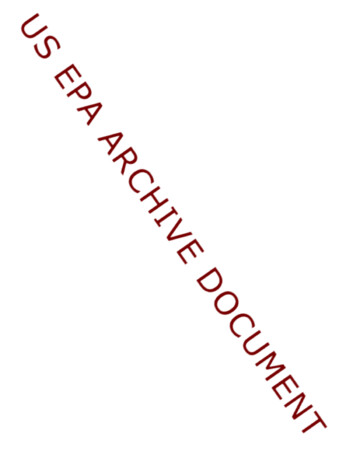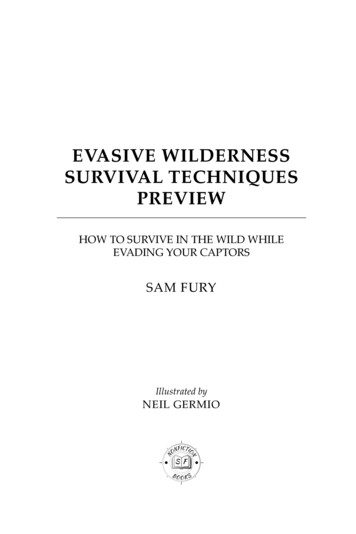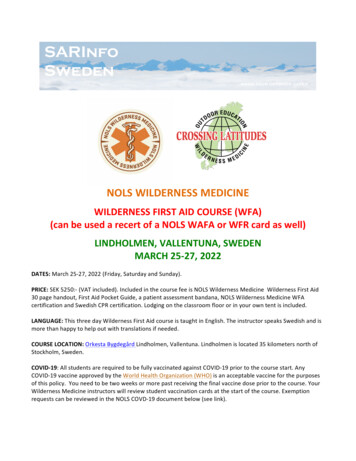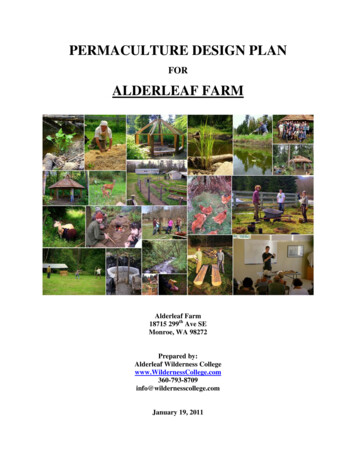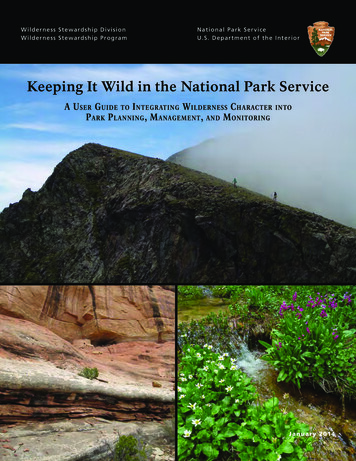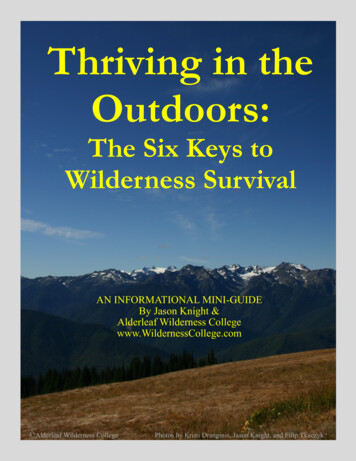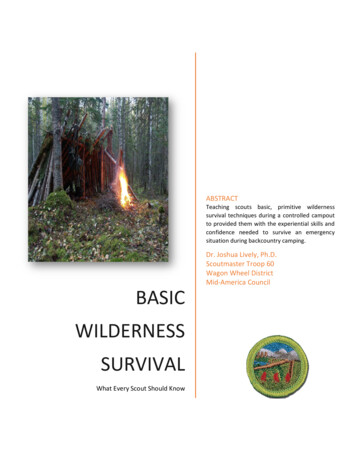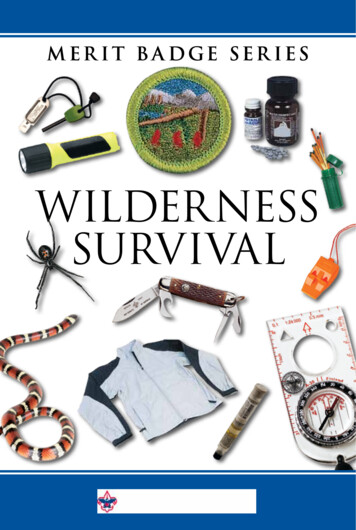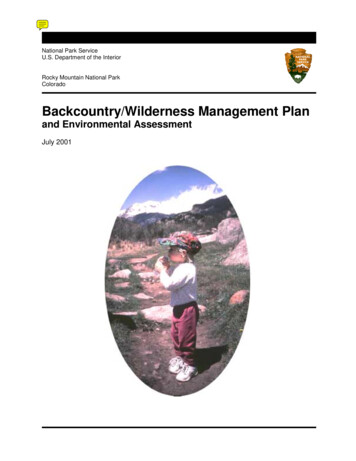
Transcription
National Park ServiceU.S. Department of the InteriorRocky Mountain National ParkColoradoBackcountry/Wilderness Management Planand Environmental AssessmentJuly 2001
Backcountry/Wilderness Management Plan and Environmental AssessmentExecutive SummaryEXECUTIVE SUMMARYThis document contains the proposed Backcountry/Wilderness Management Plan for RockyMountain National Park (RMNP) and the associated Environmental Assessment (EA). Thepurpose of the plan is to serve as:1)2)3)A public document that defines wilderness management policies and actions at RMNP;A means to identify RMNP’s wilderness vision, long range management goals, intermediateobjectives, and actions and options to meet those objectives; andA working guide for staff who manage the wilderness resource.The plan addresses issues and provides guidelines for managing the non-developed areas ofthe park that are defined as backcountry or as designated, recommended, and potentialwilderness. It details a wide array of issues and identifies specific standards for managingadministrative actions and visitor use. The plan formalizes current park backcountrymanagement practices, which have been in effect for the past twenty years; it does not affectdeveloped areas, roads, or frontcountry park uses. This plan supersedes and updates anydirection or guidance set forth in the 1984 Backcountry Management Plan. The plan’s adoptionis not a part of the recommendation before Congress to officially designate 248,464 acres(100,628 hectares) as wilderness.The EA involves analysis of two plan alternatives: the proposed plan (Preferred Alternative) andthe No Action/Current Management Alternative. The proposed plan discussion (Section 2.1)includes a detailed description of all items that comprise the plan elements. These include suchtopics as Management Classes, Resource Conditions, Visitor Experience Conditions, andAdministrative Conditions and Management Activities. Within these major headings, the planformalizes numerous standards and guidelines, many of which are already being implementedon a case-by-case basis. Standards or recommended actions are discussed for such elementsas day use and overnight group size limits, stock use, aircraft use, the Backcountry PermitSystem, campsite standards and management, climbing management, trails management, andfacilities in the backcountry and wilderness. The proposed plan provides for an enhancedwilderness interpretation and education effort and establishment of a Wilderness SteeringCommittee.The No Action/Current Management Alternative continues the current status of backcountry andwilderness management at RMNP. It differs from the proposed plan in several key areas thatare described in detail in Section 2.2 of this document. The primary difference is that therewould be no comprehensive backcountry and wilderness management plan in effect, andproposed activities in backcountry and wilderness would be reviewed and approved on a caseby-case basis, based on policies and guidelines that are not formalized, but generally followed.There could be a lack of continuity with changes in staff and/or administrations, and there wouldbe no documented process that would ensure the most consistent protection of backcountry andwilderness values.This document analyzes the potential effects of both the proposed plan and the No ActionAlternative on the natural, cultural, and social aspects of the backcountry and wildernessresource, described in Chapters 3 and 4. In general, the proposed plan includes manystandards for resource protection that would result in beneficial, long-term impacts to naturaland cultural resources, as well as a consistent review process that would have beneficial effectsRocky Mountain National ParkES-1
Backcountry/Wilderness Management Plan and Environmental AssessmentExecutive Summaryon the administration of operations in wilderness areas. There may be some adverse impactson park operations, due to limitations that would be placed on some management options. Theapplication of a Minimum Requirement Analysis for all projects would require additional stafftime and possibly result in some additional costs. Overall, cumulative beneficial impacts wouldbe expected from implementation of the plan, especially considering the potential increaseddevelopment of private lands that border RMNP.All issues and concerns were considered and the most significant of these were analyzed in detail.The potential effects of each alternative on natural and cultural resources, visitor use, local andregional economies and the Park’s environmental integrity are fully explored.ImportantIn order to be considered in the development of the final Plan and EA, comments must be receivedby close of business on March 30, 2001. Public comments will not be available for public reviewuntil after the Plan and EA comment period ends. Names and addresses of people that commenton this Plan and EA would be available to the public upon request. Copies of the Plan and EAhave been sent to public libraries in Boulder, Estes Park, Fort Collins, Grand Lake, Loveland,Longmont and Walden, Colorado. You can submit your comments to us in several ways: By mail: Superintendent, Rocky Mountain National Park, Estes Park, Colorado, 80517By e-mail: romo superintendent@nps.govBy fax: (970) 586-1310Hand deliver: Rocky Mountain National Park Headquarters, 1000 Highway 36, Estes Park,Colorado or to the Kawuneeche Valley Visitor Center, Rocky Mountain National Park, P.O.Box 100, Grand Lake, Colorado 80447Rocky Mountain National ParkES-2
Backcountry/Wilderness Management Plan and Environmental AssessmentTABLE OF CONTENTSRocky Mountain National Park
Backcountry/Wilderness Management Plan and Environmental AssessmentTable of ContentsTABLE OF CONTENTSEXECUTIVE SUMMARY. ES-11.0INTRODUCTION .1-11.11.21.31-11-11-5Scope of the Plan.Purpose and Need for This Plan .Wilderness at Rocky Mountain National Park .1.3.1 History of Wilderness and Backcountry Management/WildernessRecommendation .1.3.2 NPS Wilderness Management Policies .1.3.3 Pre-existing Conditions in RMNP Wilderness .1.3.4 Relationship of Wilderness Management to other RMNP Plans .Laws, Plans, Policies, and Authorities .1.4.1 Federal and General Provisions .1.4.2 National Park Service Provisions .1.4.3 Rocky Mountain National Park Provisions .Vision, Goals, and Objectives.Plan Review and Update .The Planning Process .1.7.1 Planning Team .1.7.2 Scoping .1.7.3 Resources and Concerns Addressed in this Plan/EA 1-20PLAN ALTERNATIVES .2-11.41.51.61.72.02.1Alternative A, Preferred Alternative (Proposed Action) .2.1.1 Management Classes/Desired Future Conditions .2.1.1.1 Management Class 1 .2.1.1.2 Management Class 2 .2.1.1.3 Management Class 3 .2.1.1.4 Management Class 4 .2.1.2 Resource Conditions .2.1.2.1 Vegetation/Soils .2.1.2.2 Fish and Wildlife .2.1.2.3 Air Quality .2.1.2.4 Aquatic Resources .2.1.2.5 Fire Management .2.1.2.6 Cultural Resources .2.1.3 Visitor Experience Conditions .2.1.3.1 Solitude .2.1.3.2 Risk and Challenge .2.1.3.3 Access/Visitor Activities/Special Uses .2.1.3.4 Impacts from Civilization .2.1.4 Administrative Conditions and Management Activities .2.1.4.1 Minimum Requirement Concept .2.1.4.2 Aircraft Use .2.1.4.3 Emergency Services .Rocky Mountain National 2-152-152-162-232-242-242-262-28i
Backcountry/Wilderness Management Plan and Environmental Assessment2.1.4.4 Backcountry Permit and Reservation System .2.1.4.5 Camp Area and Site Management .2.1.4.6 Climbing Management .2.1.4.7 Trails Management .2.1.4.8 Facilities .2.1.4.9 Research and Resource Monitoring .2.1.4.10 Wilderness Interpretation and Education .2.1.4.11 Wilderness Management Coordination .2.1.4.12 Establish Wilderness Steering Committee .Alternative B – No Action Alternative/Current Management .2.2.1 Management Classes/Desired Future Conditions .2.2.2 Resource Conditions .2.2.2.1 Vegetation/Soils .2.2.2.2 Fish and Wildlife .2.2.2.3 Aquatic Resources .2.2.2.4 Fire .2.2.2.5 Cultural .2.2.3 Visitor Experience Conditions .2.2.3.1 Solitude .2.2.3.2 Risk and Challenge .2.2.3.3 Access/Visitor Activities/Special Uses .2.2.3.4 Impacts from Civilization .2.2.4 Administrative Conditions and Management Activities .2.2.4.1 Minimum Requirement Concept .2.2.4.2 Aircraft Use .2.2.4.3 Backcountry Permit and Reservation System .2.2.4.4 Camp Area and Site Management .2.2.4.5 Climbing Management .2.2.4.6 Trails Management .2.2.4.7 Facilities Management .2.2.4.8 Research and Resource Monitoring .2.2.4.9 Interpretation and Education .2.2.4.10 Establish Wilderness Steering Committee 92-692-692-692-692-702-702-702-71DESCRIPTION OF THE BACKCOUNTRY/WILDERNESSRESOURCE (Affected Environment) .3-12.23.0Table of Contents3.13.2Regional Context and General Description .Natural, Cultural and Social Aspects of the Wilderness Resource .3.2.1 Geology, Soils, and Vegetation .3.2.2 Wetlands, Floodplains, and Aquatic Resources .3.2.3 Wildlife and Threatened, Endangered, and Special StatusSpecies .3.2.4 Natural Quiet, Sounds, and Lights .3.2.5 Air Quality .3.2.6 Cultural Resources .3.2.7 Local Socioeconomics .3.2.8 Visitor Use and Experience .3.2.9 Park Operations .Rocky Mountain National Park3-13-13-13-23-33-43-43-53-73-73-8ii
Backcountry/Wilderness Management Plan and Environmental Assessment4.0Table of ContentsENVIRONMENTAL CONSEQUENCES .4-14.14.24-1Impact Assessment Methodology .Impacts on the Natural, Cultural, and Social Aspects of the WildernessResource .4.2.1 Geology, Soils, and Vegetation .4.2.2 Wetlands, Floodplains, and Aquatic Resources .4.2.3 Wildlife and Threatened, Endangered, or Special Status Species .4.2.4 Natural Quiet, Sounds, and Lights .4.2.5 Air Quality .4.2.6 Cultural Resources .4.2.7 Local Socioeconomics .4.2.8 Visitor Use and Experience (including Natural Quiet, Sounds, andLights) .4.2.9 Park Operations .Cumulative Impacts–All Resource Areas .4-104-114-135.0CONSULTATION AND COORDINATION .5-16.0LIST OF PREPARERS AND PRINCIPAL CONTRIBUTORS .6-17.0REFERENCES .7-14.34-14-24-34-54-64-84-84-9FIGURESFigure 1-1 Map of Park/Regional Context.Figure 1-2 RMNP Wilderness Recommendation .Figure 1-3 Adjoining Wilderness.Figure 1-4 Backcountry Overnight Use (1960-1999).1-21-31-41-7Figure 2-1 Management Classes.Figure 2-2 Summer Backcountry Camp Areas .Designated SitesStock SitesCrosscountry AreasBivouac AreasFigure 2-3 Winter Backcountry Camp Areas.Figure 2-4 Trail System .2-52-312-332-42TABLESTable 2-1 Comparison of Standards between Alternatives .Rocky Mountain National Park2-72iii
Backcountry/Wilderness Management Plan and Environmental AssessmentTable of ContentsAPPENDICESAppendix A Endangered, Threatened and Rare Species.A-1Appendix B Backcountry/Wilderness Cultural Resources Protection Protocols .B-1Appendix C Current Inventories.C-1Table 1 Camp Area Summary.Table 2 Designated Camp Area/Sites .Table 3 Crosscountry Areas .Table 4 Bivouac Areas.Table 5 Winter Areas .Table 6a Trail Mileage Summary by Planning Unit and Standard .Table 6b Existing Trail System.Table 7 Hitchrails .Table 8 Corrals .Table 9 Bridge and Footlog Summary by Planning Unit .Table 10 Structures .Table 11 Privies ix D Minimum Requirement Analysis Worksheet and Instructions .D-1Appendix E Backcountry Permit .E-1Appendix F Trail Standards .F-1Table 1 Trail Standards Summary.Table 2 Trail Standards Detail.F-1F-2Appendix G Leave No Trace Principles .G-1Rocky Mountain National Parkiv
Backcountry/Wilderness Management Plan and Environmental Assessment1.0 INTRODUCTIONRocky Mountain National Park
Backcountry/Wilderness Management Plan and Environmental Assessment1.0INTRODUCTION1.1Scope of the PlanIntroductionRocky Mountain National Park (RMNP or the Park) encompasses 265,769.14 acres (107,556hectares) and is located in north-central Colorado in portions of Larimer, Boulder, and GrandCounties (see Figure 1-1). The towns of Allenspark, Glen Haven, Estes Park, Meeker Park, andGrand Lake are found along its borders. Currently, within RMNP, approximately 2.9 percent,7,482 acres ( 3,028 hectares) is developed, 2.1 percent, 5,759 acres (2,330 hectares) isbackcountry, 93.5 percent, 248,464 acres (100,628 hectares) is recommended wilderness, 0.4percent, 1,147 acres (465 hectares) is potential wilderness, and 1.1 percent, 2,917 acres (1,181hectares) is designated wilderness (see Figure 1-2). Refer to Section 1.3.1 for history of theWilderness Recommendation. Lands bordering RMNP are a mixture of state, local, private, andfederal lands. About 62 percent of the Park boundary borders National Forest Land, with 70percent of the adjacent Forest lands managed as designated wilderness (see Figure 1-3). The restof the Park boundary borders subdivisions, summer camps, and burgeoning town populations.This Backcountry/Wilderness Management Plan addresses issues and provides guidelines formanaging the non-developed areas of RMNP that are defined as backcountry (any area morethan 100 feet from developed areas or roads) or as designated, recommended, or potentialwilderness. As further discussed in Section 1.3.2 below, the scope of this plan includes bothdesignated and recommended wilderness, per NPS Management Policies 2001 (6.3.1). Sincebackcountry and wilderness do not include the developed areas of RMNP, issues which pertainspecifically to developed areas are not within the purview of this Backcountry/WildernessManagement Plan.This plan supersedes any direction or guidance set forth in the 1984 Backcountry ManagementPlan. Within this framework, this plan provides direction for management of natural and culturalresources within the context of wilderness and backcountry management policies, with primaryfocus on visitor use and impacts to wilderness values and resources and administrative actionsto mitigate associated impacts. It also sets the tone and increases awareness of the way thepublic and park staff looks at the wilderness and backcountry character and resources ofRMNP.The scope of this plan does not involve any proposed approval, action, or documentation that isdirectly related to the recommendation before Congress to officially designate 248,464 acres(100,628 hectares) of RMNP as wilderness. This plan and current actions and policies of thePark must treat any proposed or recommended wilderness the same as officially designatedwilderness, based on NPS Management Policies 2001 (6.3.1).1.2Purpose and Need For This PlanThe purpose of this Backcountry/Wilderness Management Plan is to serve as:1)2)3)A public document that defines wilderness management policies and actions used at RockyMountain National Park (RMNP or “the Park”);A means to identify RMNP’s wilderness vision, long range management goals, intermediateobjectives, and actions and options to meet those objectives; andA working guide for staff who manage the wilderness resource.Rocky Mountain National Park1-1
Backcountry/Wilderness Management Plan and Environmental AssessmentIntroductionFigure 1-1Rocky Mountain National Park1-2
Backcountry/Wilderness Management Plan and Environmental AssessmentRocky Mountain National ParkIntroduction1-3
Backcountry/Wilderness Management Plan and Environmental AssessmentIntroductionFigure 1-3Rocky Mountain National Park1-4
Backcountry/Wilderness Management Plan and Environmental AssessmentIntroductionNational Park Service (NPS) policy states that "each park containing wilderness will develop andmaintain a wilderness management plan to guide the preservation, management, and use of thatwilderness." In addition, Director Roger Kennedy outlined several key park responsibilities withregard to wilderness management in a memorandum to park superintendents dated November 4,1994. One such responsibility for the RMNP was to "ensure that your park has a wilderness/backcountry plan completed by the year 2000." Director Robert Stanton reaffirmed this direction inhis own memorandum dated February 27, 1998, in which he directed parks to have a current,approved wilderness management plan as soon as possible, but no later than the year 2002.Other reasons for developing this plan include the following: The current Backcountry Management Plan was approved in 1984. There are many soundprinciples and good guidance in that plan; however, it mainly addresses overnight use ofthe backcountry. Several visitor and administrative uses have since changed and need tobe addressed. Overnight use in RMNP has steadily increased since the mid 1980's. It is important toreview and revise, if necessary, the Park’s management policies and guidelines withrespect to overnight use and the permitting process. The population along the Front Range of Colorado continues to grow, and visitation toRMNP topped three million in 1994. As a result, day use and its associated impacts haveincreased significantly. Appropriate management actions are needed to protect thewilderness resources for present and future generations. Finally, new technology continues to play a role in how wilderness areas are managed andrequires consideration to protect natural resources and visitor experience. Appropriateuses need to be discussed and guidance provided.1.3Wilderness at Rocky Mountain National Park1.3.1History of Wilderness and Backcountry Management/WildernessRecommendationRocky Mountain National Park has always been recognized for its wilderness character. Manyof the management plans developed have addressed various aspects of the wilderness foundwithin RMNP. In 1984, the current Backcountry Management Plan was approved, whichincludes principles and guidance for wilderness management. However, the 1984 plan andearlier versions primarily focused on overnight use of the backcountry.Total park visitation continues to increase. Since 1994 visitation has topped three millionannually. Many visitors enter the wilderness/backcountry for day and overnight trips.Documentation of current day use levels is limited. A 1977 backcountry/wilderness day usestudy estimates hikers at 700,000 per year (Tarhan, 1977). In 1994 and 1995 an exit survey of4,000 visitors was conducted, in which 48 percent of the respondents stated hiking was a mainactivity. Considering current park visitation figures, this would more than double the 1977estimate. Park management for day use has included hardening trails and high use destinationsites, dispersing use throughout RMNP, and educating the public on impacts they may cause.Rocky Mountain National Park1-5
Backcountry/Wilderness Management Plan and Environmental AssessmentIntroductionStatistical trends of overnight backcountry use can be seen from the Park’s earliest recordsbeginning in 1960 (see Figure 1-4). Annual user night use of 13,795 continued a steadyincrease to a peak of use in 1977, with 62,708 user nights. This was followed by a decline to32,705 user nights in 1987, followed again by a steady increase to a total of 41,772 user nightsin 1999. The backcountry of RMNP is an ever-increasing destination for those seeking a qualitywilderness experience.The Backcountry Permit System developed prior to 1968 in response to the overuse and severeimpacts that had appeared in high use backcountry areas within RMNP. Many of the campareas were near popular high country lakes. It was reported in those years that the popularFern Lake area was often crowded with over 200 people on busy weekends. One report fromPark Ranger Bob Haines said that “there were tents, fires and pits toilets everywhere even rightup to the edge of the lake”. The impacts were highly visible and severe.Park officials, in an attempt to mitigate these impacts, instituted a permit system in order toregulate and more evenly distribute backcountry use. This system allowed for focused impactsin specified areas that could be directly managed. The system was administered on a “firstcome, first served” basis.An advance reservation system for overnight use was initiated in July 1974. Fifty percent ofRMNP’s then 200 backcountry campsites were included in the reservation system. The other100 sites continued to be on a 24-hour advance “first come, first served" basis as had been inthe past. Designated sites at this time allowed 1-7 people, and group limits permitted 8-25people for overnight camping. There were no fees for backcountry use or the administration ofbackcountry permits.In the summer of 1976, due to the difficulty of administering 50 percent of the sites byreservation and 50 percent by "first come, first served", all backcountry campsites weretransferred to the reservation system. Sites that had not been reserved in advance were, ofcourse, still available on a “first come, first served” basis. In May 1976, group site limits werereduced from 25 to 20, and night limits increased from seven (7) nights total allowed year-roundto seven (7) nights from June - September and an additional 15 nights allowed from October May, for a total of 21 nights allowed year-round. Beginning in approximately November 1976,self-registration boxes for backcountry permits were placed at strategic trailheads (Wild Basin,Long’s Peak, and North Fork) during the winter months instigated by staffing constraints and forthe convenience of park visitors. In January 1993, overnight group size limits were reducedagain from 20 (summer) and 15 (winter) to 12 (year-round), due to high impacts and decliningnational trends.From 1968 to 1994, the reservation system was entirely tracked by hand. Due to the incredibleworkload and advance in computer technology, the current Backcountry Reservation Systemwas computerized and put online on January 1, 1994. The system was designed anddeveloped in park by the Computer Specialist, Wilderness Program Specialist, and BackcountryOffice Manager. The system is reviewed, improved, and updated annually.Rocky Mountain National Park1-6
Backcountry/Wilderness Management Plan and Environmental AssessmentIntroduction70 ,0 0 06ROCKY MOUNTAIN NATIONAL PARKBACKCOUNTRY USER NIGHTS 1960 - 19992,7086 0 ,0 0 0554,87,66653565526274,0,48240,963,5551,945 0 ,0 0 3133514,414,7,7,03 0 ,0 0 0,5423330,723800,1,461839625U s er N ig h ts77432,1,632823424,0,01,244444 0 ,0 0 027,12922 0 ,0 0 01,05813,79510 ,0 0 010,56,630152,638,9994287211,465,
By mail: Superintendent, Rocky Mountain National Park, Estes Park, Colorado, 80517 By e-mail: romo_superintendent@nps.gov By fax: (970) 586-1310 Hand deliver: Rocky Mountain National Park Headquarters, 1000 Highway 36, Estes Park, Colorado or to the Kawuneeche Valley Visitor Ce


